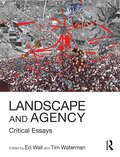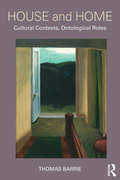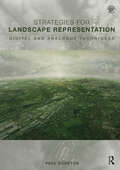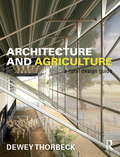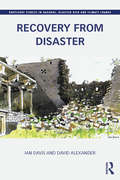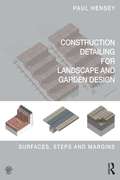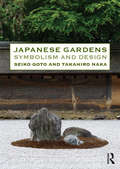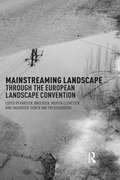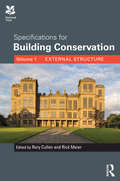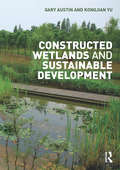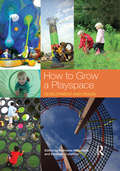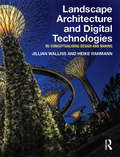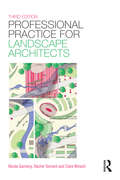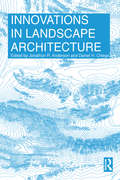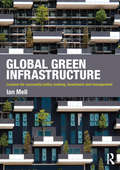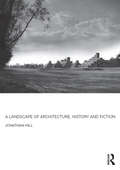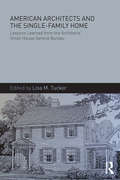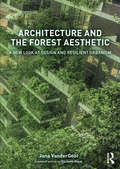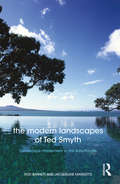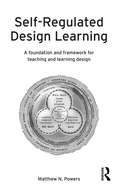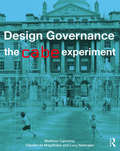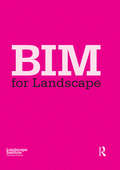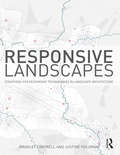- Table View
- List View
Landscape and Agency: Critical Essays
by Ed Wall Tim WatermanLandscape and Agency explores how landscape, as an idea, a visual medium and a design practice, is organized, appropriated and framed in the transformation of places, from the local to the global. It highlights how the development of the idea of agency in landscape theory and practice can fundamentally change our engagement with future landscapes. Including a wide range of international contributions, each illustrated chapter investigates the many ways in which the relationship between the ideas and practices of landscape, and social and subjective formations and material processes, are invested with agency. They critically examine the role of landscape in processes of contemporary urban development, environmental debate and political agendas and explore how these relations can be analysed and rethought through a dialogue between theory and practice.
Creating the Productive Workplace: Places to Work Creatively
by Derek Clements-CroomeThe built environment affects our physical, mental and social well-being. Here renowned professionals from practice and academia explore the evidence from basic research as well as case studies to test this belief. They show that many elements in the built environment contribute to establishing a milieu which helps people to be healthier and have the energy to concentrate while being free to be creative. The health and well-being agenda pervades society in many different ways but we spend much of our lives in buildings, so they have an important role to play within this total picture. This demands us to embrace change and think beyond the conventional wisdom while retaining our respect for it. Creating the Productive Workplace shows how we need to balance the needs of people and the ever-increasing enabling technologies but also to take advantage of the healing powers of Nature and let them be part of environmental design. This book aims to lead to more human-centred ways of designing the built environment with deeper meaning and achieve healthier and more creative, as well as more productive places to work.
House and Home: Cultural Contexts, Ontological Roles
by Thomas BarrieHouse and home are words routinely used to describe where and how one lives. This book challenges predominant definitions and argues that domesticity fundamentally satisfies the human need to create and inhabit a defined place in the world. Consequently, house and home have performed numerous cultural and ontological roles, and have been assiduously represented in scripture, literature, art, and philosophy. This book presents how the search for home in an unpredictable world led people to create myths about the origins of architecture, houses for their gods, and house tombs for eternal life. Turning to more recent topics, it discusses how writers often used simple huts as a means to address the essentials of existence; modernist architects envisioned the capacity of house and home to improve society; and the suburban house was positioned as a superior setting for culture and family. Throughout the book, house and home are critically examined to illustrate the perennial role and capacity of architecture to articulate the human condition, position it more meaningfully in the world, and assist in our collective homecoming.
Strategies for Landscape Representation: Digital and Analogue Techniques
by Paul CuretonStrategies for Landscape Representation discusses a variety of digital and analogue production techniques for the representation of landscape at multiple scales. Careful consideration is required to represent time, and to ensure accuracy of representation and evaluation in the landscape.Written as a guide for making appropriate selection of a wide variety of visualisation tools for students and built environment professionals with an interest in landscape, the book charts emerging technologies and historical contexts whilst also being relevant to landscape legislation such as Building Information Modelling (BIM) and Landscape Assessment. This book is an innovation-driven text that encourages readers to make connections between software, technology and analogue modes. The management, choice and combination of such modes can arguably narrow the unknown of landscape character, address the issues of representing time and change in landscape and engage and represent communities’ perceptions and experience of landscape.Showcasing international examples from landscape architecture, planning, urban design and architecture, artists, visualisers, geographers, scientists and model makers, the vitality of making and intrinsic value of representational work in these processes and sites is evidenced. An accompanying companion website provides access to original source files and tutorials totalling over a hundred hours in mapping and GIS, diagrams and notation, photomontage, 3D modelling and 3D printing.
Architecture and Agriculture: A Rural Design Guide
by Dewey ThorbeckArchitecture and Agriculture: A Rural Design Guide presents architectural guidelines for buildings designed and constructed in rural landscapes by emphasizing their connections with function, culture, climate, and place. Following on from the author’s first book Rural Design, the book discusses in detail the buildings that humans construct in support of agriculture. By examining case studies from around the world including Australia, China, Japan, Norway, Poland, Japan, Portugal, North America, Africa and the Southeast Asia it informs readers about the potentials, opportunities, and values of rural architecture, and how they have been developed to create sustainable landscapes and sustainable buildings for rapidly changing rural futures.
Recovery from Disaster (Routledge Studies in Hazards, Disaster Risk and Climate Change)
by David Alexander Ian DavisDisasters can dominate newspaper headlines and fill our TV screens with relief appeals, but the complex long-term challenge of recovery—providing shelter, rebuilding safe dwellings, restoring livelihoods and shattered lives—generally fails to attract the attention of the public and most agencies. On average 650 disasters occur each year. They affect more than 200 million people and cause $166 trillion of damage. Climate change, population growth and urbanisation are likely to intensify further the impact of natural disasters and add to reconstruction needs. Recovery from Disaster explores the field and provides a concise, comprehensive source of knowledge for academics, planners, architects, engineers, construction managers, relief and development officials and reconstruction planners involved with all sectors of recovery, including shelter and rebuilding. With almost 80 years of first-hand experience of disaster recovery between them, Ian Davis (an architect) and David Alexander (a geographer) draw substantially from first-hand experiences in a variety of recovery situations in China, Haiti, Italy, Japan, New Zealand, Pakistan, the Philippines and the USA. The volume is further enriched by two important and unique features: 21 models of disaster recovery are presented, seven of which were specifically developed for the book. The second feature is a survey of expert opinion about the nature of effective disaster recovery—the first of its kind. More than 50 responses are provided in full, along with an analysis that integrates them with the theories that underpin them. By providing a framework and models for future study and applications, Davis and Alexander seek both to advance the field and to provide a much-needed reference work for decision makers. With a broad perspective derived from the authors' roles held as university professors, researchers, trainers, consultants, NGO directors and advisors to governments and UN agencies, this comprehensive guide will be invaluable for practitioners and students of disaster management.
Construction Detailing for Landscape and Garden Design: Surfaces, steps and margins
by Paul HenseyDesigns for gardens and landscapes need to contain accurate information to ensure that both the designer’s intent is clear and to enable the highest quality constructions. This book contains the elements most often used when detailing surfaces, with key information on standards, guidance and construction that the practitioner must be aware of. Alongside the text are 2D and 3D images with suggestions of measurements, design considerations and materials. Key topics covered in this book are: Vehicular paving Pedestrian paving and patios Steps and ramps Margins, edges and kerbs Drainage channels To be used in conjunction with the book is an innovative online library of freely downloadable CAD (SketchUp format) details which link directly to those in the book. These details are available for the reader to edit, adapt and use in their own designs - and make the task of detailing for projects that little bit easier.
Japanese Gardens: Symbolism and Design
by Seiko Goto Takahiro NakaThe unique beauty of the Japanese garden stems from its spirituality and rich symbolism, yet most discussions on this kind of garden rarely provide more than a superficial overview. This book takes a thorough look at the process of designing a Japanese garden, placing it in a historical and philosophical context. Goto and Naka, both academic experts in Japanese garden history and design, explore: The themes and usage of the Japanese garden Common garden types such as tea and Zen gardens Key maintenance techniques and issues. Featuring beautiful, full-colour images and a glossary of essential Japanese terms, this book will dramatically transform your understanding of the Japanese garden as a cultural treasure.
Mainstreaming Landscape through the European Landscape Convention
by Tim Richardson Morten Clemetsen Anne-Karine Halvorsen Thoren Karsten JorgensenThe European Landscape Convention has introduced a Europe-wide concept of protection, management and planning of all landscapes – not just the outstanding ones. This book reflects on the background to the establishment of the convention, takes a critical look at examples and experiences of its implementation, and discusses future developments for the convention and the management of landscapes in Europe. A decade after the creation of the European Landscape Convention, this book asks how it has influenced the governance and development of European landscapes, and what role it will play in the coming years. The authors provide a wide range of analyses, reflections and visions, informed by their diverse experiences of researching, working with and using the convention. The sixteen essays are organised into three sections, focusing on the fundamental concepts and values behind the convention, current projects and experiences of implementation, and prospects for future developments.
Specifications for Building Conservation: Volume 1: External Structure
by Rick Meier Rory CullenIn Specifications for Building Conservation, the National Trust draws on a range of case studies and specifications to provide a much needed guide to specification writing for building conservation. Although traditional building accounts for approximately a quarter of all buildings in the UK, the old skills and understanding required for their care and maintenance have been increasingly eroded over the last century. As the largest heritage charity in Europe, the National Trust has a first class reputation for high standards of conservation and care, and in this three volume set, the Trust brings together a remarkable pool of expertise to guide conservation professionals and students through the process of successful specification writing. This first book focusses on the materials used for the external fabric, detailing successful approaches employed by the National Trust at some of their most culturally significant sites. A range of studies have been carefully selected for their interest, diversity and practicality; showcasing projects from stonework repairs on the magnificent Grade I listed Hardwick Hall to the re-thatching of the traditional cottages of the Holnicote Estate. Complete with a practical Conservation Management Plan checklist, this book will enable practitioners to develop their skills, allowing them to make informed decisions when working on a range of project types. This is the first practical guide to specification writing for building conservation and the advice provided by the National Trust experts will be of interest to any practitioners and students involved in building conservation, both in the UK and beyond. Profits generated from the sale of this publication will go to the National Trust Building Apprenticeship Scheme. This provides placements for traditional skills at National Trust properties.
Constructed Wetlands and Sustainable Development
by Gary Austin Kongjian YuThis book explains how with careful planning and design, the functions and performance of constructed wetlands can provide a huge range of benefits to humans and the environment. It documents the current designs and specifications for free water surface wetlands, horizontal and vertical subsurface flow wetlands, hybrid wetlands and bio retention basins; and explores how to plan, engineer, design and monitor these natural systems. Sections address resource management (landscape planning), technical issues (environmental engineering and botany), recreation and physical design (landscape architecture), and biological systems (ecology). Site and municipal scale strategies for flood management, storm-water treatment and green infrastructure are illustrated with case studies from the USA, Europe and China, which show how these principles have been put into practice. Written for upper level students and practitioners, this highly illustrated book provides designers with the tools they need to ensure constructed wetlands are sustainably created and well manage
How to Grow a Playspace: Development and Design
by Katherine Masiulanis Elizabeth CumminsHow to Grow a Playspace takes you through a global perspective of the different stages of child development and the environments that engage children in play around the world. From the urbanity of Mumbai; to rainbow nets in Japan; nature play in Denmark; recycling waste in Peru; community building in Uganda; play streets in London; and gardens of peace in Palestine, it proves that no matter where play occurs, it is ubiquitous in its resourcefulness, imagination and effect. Written by international leaders in the field of play including academics, designers and playworkers, How to Grow A Playspace discusses contemporary issues around children and play, such as risk benefit in play, creativity and technology, insights into children’s thinking, social inclusion and what makes a city child-friendly. With its own ‘Potting Shed’, this text is also a practical guide to support playspace projects with advice on teams, budgets, community engagement, maintenance and standards. How to Grow a Playspace is a comprehensive ‘go-to’ guide for anyone interested or involved in children’s play and playspaces.
Landscape Architecture and Digital Technologies: Re-conceptualising design and making
by Jillian Walliss Heike RahmannLandscape Architecture and Digital Technologies explores how digital technologies are reshaping design and making in landscape architecture. While the potentials of digital technologies are well documented within landscape planning and visualisation, their application within design practice is far less understood. This book highlights the role of the digital model in encouraging a new design logic that moves from the privileging of the visual to a focus on processes of formation, bridging the interface of the conceptual and material, the virtual and the physical. Drawing on interviews and projects from a range of international designers -including , Snøhetta, Arup, Gustafson Porter, ASPECT Studios, Grant Associates, Catherine Mosbach, Philippe Rahm, PARKKIM, LAAC and PEG office of landscape + architecture among others, the authors explore the influence of parametric modelling, scripting, real-time data, simulation, prototyping, fabrication, and Building Information Modelling on the design and construction of contemporary landscapes. This engagement with practice is expanded through critical reflection from academics involved in landscape architecture programs around the world that are reshaping their research and pedagogy to reflect an expanded digital realm. Crossing critical theory, technology and contemporary design, the book constructs a picture of an emerging twenty-first century practice of landscape architecture practice premised on complexity and performance. It also highlights the disciplinary demands and challenges in engaging with a rapidly evolving digital context within practice and education. The book is of immense value to professionals and researchers, and is a key publication for digital landscape courses at all levels.
Landscape Architecture and Digital Technologies: Re-conceptualising design and making
by Jillian Walliss Heike RahmannLandscape Architecture and Digital Technologies explores how digital technologies are reshaping design and making in landscape architecture. While the potentials of digital technologies are well documented within landscape planning and visualisation, their application within design practice is far less understood. This book highlights the role of the digital model in encouraging a new design logic that moves from the privileging of the visual to a focus on processes of formation, bridging the interface of the conceptual and material, the virtual and the physical. Drawing on interviews and projects from a range of international designers -including , Snøhetta, Arup, Gustafson Porter, ASPECT Studios, Grant Associates, Catherine Mosbach, Philippe Rahm, PARKKIM, LAAC and PEG office of landscape + architecture among others, the authors explore the influence of parametric modelling, scripting, real-time data, simulation, prototyping, fabrication, and Building Information Modelling on the design and construction of contemporary landscapes. This engagement with practice is expanded through critical reflection from academics involved in landscape architecture programs around the world that are reshaping their research and pedagogy to reflect an expanded digital realm. Crossing critical theory, technology and contemporary design, the book constructs a picture of an emerging twenty-first century practice of landscape architecture practice premised on complexity and performance. It also highlights the disciplinary demands and challenges in engaging with a rapidly evolving digital context within practice and education. The book is of immense value to professionals and researchers, and is a key publication for digital landscape courses at all levels.
Professional Practice for Landscape Architects
by Rachel Tennant Nicola Garmory Clare WinschProfessional Practice for Landscape Architects third edition deals with the practical issues of being a successful landscape architect professional. Endorsed by the Landscape Institute, this book is an indispensable guide for licentiate members of the Institute on their Pathway to Chartership. It follows the revised 2013 syllabus covering all aspects of professional judgement, ethics and values, the legal system, organisation and management, legislation and the planning system, environmental policy and control, procurement and implementation. It also serves as a reminder and reference for fully qualified professionals in their everyday practice and for landscape students. Valuable information is presented in an easy to follow manner with diagrams and schedules, key acts, professional documents and contracts clearly explained and made easy to understand. A handy list of questions are included to aid with P2C revision, answers of which are found within the text.
Innovations in Landscape Architecture
by Jonathon R. Anderson Daniel H. OrtegaThis inspiring and thought-provoking book explores how recent innovations in landscape architecture have uniquely positioned the practice to address complex issues and technologies that affect our built environment. The changing and expanding nature of "landscape" make it more important than ever for landscape architects to seek innovation as a critical component in the forward development of a contemporary profession that merges expansive ideas and applications. The editors bring together leading contributors who are experts in new and pioneering approaches and technologies within the fields of academic and professional landscape architecture. The chapters explore digital technology, design processes and theoretical queries that shape the contemporary practice of landscape architecture. Topics covered include: Digital design Fabrication and prototyping Emerging technology Visualization of data System theory Concluding the book are case studies looking at the work of two landscape firms (PEG and MYKD) and two academic departments (Illinois Institute of Technology and the Rhode Island School of Design), which together show the novel and exciting directions that landscape is already going in.
Global Green Infrastructure: Lessons for successful policy-making, investment and management
by Ian MellOver the last decade research exploring green infrastructure planning has burgeoned. Transferable green infrastructure messages between locations though are less well established and there remains a visible gap between the conceptual understanding of green infrastructure and its application in practice. Drawing together evaluations of green infrastructure policy-making and practice from across the world Global Green Infrastructure illustrates where successful practices can be identified. Examples from major green infrastructure development areas in the UK, Europe and the USA highlight the variety of investment options that can deliver socio-economic benefits. There is also a growing awareness of the added value of landscape planning in the rapidly developing cities of India and China. Reflecting on ten international case studies Global Green Infrastructure highlights the ways that ecology and engineered solutions can deliver successful urban development. Based on in situ research with the growing community of green infrastructure researchers and practitioners Global Green Infrastructure looks at the contradictions, consensus, and expanding evidence base of successful investments. This book also presents an in-depth commentary on the contemporary approaches to investment in urban greening and green infrastructure, and draws on the lessons we have learnt from a decade of experimentation, delivery and reflection.
A Landscape of Architecture, History and Fiction
by Jonathan HillArchitecture can be analogous to a history, a fiction, and a landscape. We expect a history or a novel to be written in words, but they can also be cast in concrete or seeded in soil. The catalyst to this tradition was the simultaneous and interdependent emergence in the eighteenth century of new art forms: the picturesque landscape, the analytical history, and the English novel. Each of them instigated a creative and questioning response to empiricism’s detailed investigation of subjective experience and the natural world, and together they stimulated a design practice and lyrical environmentalism that profoundly influenced subsequent centuries. Associating the changing natural world with journeys in self-understanding, and the design process with a visual and spatial autobiography, this book describes journeys between London and the North Sea in successive centuries, analysing an enduring and evolving tradition from the picturesque and romanticism to modernism. Creative architects have often looked to the past to understand the present and imagine the future. Twenty-first-century architects need to appreciate the shock of the old as well as the shock of the new.
American Architects and the Single-Family Home: Lessons Learned from the Architects' Small House Service Bureau
by Lisa M. TuckerAmerican Architects and the Single-Family Home explains how a small group of architects started the Architects’ Small House Service Bureau in 1919 and changed the course of twentieth-century residential design for the better. Concepts and principles they developed related to public spaces, private spaces, and service spaces for living; details about the books they published to promote good design; as well as new essays from contemporary practitioners will inspire your own designs. More than 200 black and white images.
Architecture and the Forest Aesthetic: A New Look at Design and Resilient Urbanism
by Jana VanderGootDespite population trends toward urbanization, the forest continues to have a strong appeal to the human imagination, and the human preference for forest over many other types of terrain is well documented. This book re-imagines architecture and urbanism by allowing the forest to be a prominent consideration in the language of design, thus recognizing the forest as essential rather than just incidental to human well-being. In Architecture and the Forest Aesthetic, forest is a large-scale urban construct that is far more extensive and nuanced than trees and shrubbery. The forest aesthetic opens designers to the forest as a model for an urban architecture of permeable floors, protective canopies, connected food chains, beneficial decomposition, and resilient ecologies. Much can be learned about these features of the forest from the natural sciences; however, when they are given due consideration technically and metaphorically in the design of urban habitat, the places in which humans live become living forests. What is present here in Architecture and the Forest Aesthetic is both a review of many ingenious ways in which the forest aesthetic has already been expressed in design and urbanism, and an encouragement to further use the forest aesthetic in design language and design outcomes. Case study projects featured include the Chilotan building craft of Southern Chile, the yaki sugi of Japan, the Biltmore Forest in the Southeastern United States, the Australian capital city Canberra, Bosco Verticale in Milan, Italy, the Beijing Olympic Forest Park in China, and more.
The Modern Landscapes of Ted Smyth: Landscape Modernism in the Asia-Pacific
by Jacqueline Margetts Rod BarnettThe modern period in landscape architecture is enjoying the fascinated appreciation of scholars and historians in Europe and the Americas, and new themes, new subjects and new appraisals are appearing. This book contributes to the conversation by focusing on the work of a singular designer who spent his entire career in a province of the North Island of New Zealand. Ted Smyth practiced an assured landscape modernism without ever seeing the designs of his forebears or his contemporaries working in the UK, Europe and the United States. Designing in isolation from the mainstream of modernism, and a little after its high tide, Smyth produced a series of gardens that provoke a revaluation of the diffusionist model of influence. The book explains and describes the evolution of Smyth’s design vocabulary and relates it to the development of tropical landscape modernism in other Asia-Pacific sites. It shows how a culture of garden modernism can be generated from within a particular locale, and highlights Smyth’s engagement with Māori design traditions in search of a specific expression of the high modern essentialism of place.
Self-Regulated Design Learning: A Foundation and Framework for Teaching and Learning Design
by Matthew N. PowersSelf-Regulated Design Learning: A Foundation and Framework for Teaching and Learning Design reframes how educators in architecture, landscape architecture, and other design disciplines think about teaching and learning design. The book weaves together concepts of constructivism, social cognitive theory, and self-regulated learning into a solid theoretical foundation for innovative teaching that emphasizes meaning, memory, problem solving, and mastery. The central goal of self-regulated design learning is making design learnable so that students are encouraged to become active, engaged participants in the design learning process. Key features of the book include: examining the issues, values, and challenges of teaching and learning in design, exploring select educational theories and concepts relevant to design pedagogy, illustrating the pivotal relationships between design learning and self-regulation, and discussing pedagogic techniques that support self-regulated design learning and lead to greater student achievement and performance. Self-Regulated Design Learning: A Foundation and Framework for Teaching and Learning Design provides numerous examples and applications to help design educators understand how to implement the self-regulated design learning methodology in their studios. Through this book, design educators will discover new ways of encouraging meaningful design learning through an advanced approach that is empowering, inspiring, and vital.
Design Governance: The CABE Experiment
by Matthew Carmona Claudio De Magalhaes Lucy NatarajanDesign Governance focuses on how we design the built environment where most of us live, work, and play and the role of government in that process. To do so, it draws on the experience of the Commission for Architecture and the Built Environment (CABE), a decade-long, globally unique experiment in the governance of design. This book theorises design governance as an arm and aspiration of the state; tells the story of CABE, warts and all, and what came before and after; unpacks CABE’s ‘informal’ toolbox: its methods and processes of design governance; and reflects on the effectiveness and legitimacy of design as a tool of modern-day government. The result is a new set of concepts through which to understand the governance of design as a distinct and important sub-field of urban design.
BIM for Landscape
by Landscape InstituteBIM (Building Information Modelling) is transforming working practices across the built environment sector, as clients, professionals, contractors and manufacturers throughout the supply chain grasp the opportunities that BIM presents. The first book ever to focus on the implementation of BIM processes in landscape and external works, BIM for Landscape will help landscape professionals understand what BIM means for them. This book is intended to equip landscape practitioners and practices to meet the challenges and reap the rewards of working in a BIM environment - and to help professionals in related fields to understand how BIM processes can be brought into landscape projects. BIM offers significant benefits to the landscape profession, and heralds a new chapter in inter-disciplinary relationships. BIM for Landscape shows how BIM can enhance collaboration with other professionals and clients, streamline information processes, improve decision-making and deliver well-designed landscape projects that are right first time, on schedule and on budget. This book looks at the organisational, technological and professional practice implications of BIM adoption. It discusses in detail the standards, structures and information processes that form BIM Level 2-compliant workflows, highlighting the role of the landscape professional within the new ways of working that BIM entails. It also looks in depth at the digital tools used in BIM projects, emphasising the ‘information’ in Building Information Modelling, and the possibilities that data-rich models offer in landscape design, maintenance and management. BIM for Landscape will be an essential companion to the landscape professional at any stage of their BIM journey.
Responsive Landscapes: Strategies for Responsive Technologies in Landscape Architecture
by Justine Holzman Bradley E CantrellThe sensing, processing, and visualizing that are currently in development within the environment boldly change the ways design and maintenance of landscapes are perceived and conceptualised. This is the first book to rationalize interactive architecture and responsive technologies through the lens of contemporary landscape architectural theory. Responsive Landscapes frames a comprehensive view of design projects using responsive technologies and their relationship to landscape and environmental space. Divided into six insightful sections, the book frames the projects through the terms; elucidate, compress, displace, connect, ambient, and modify to present and construct a pragmatic framework in which to approach the integration of responsive technologies into landscape architecture. Complete with international case studies, the book explores the various approaches taken to utilise responsive technologies in current professional practice. This will serve as a reference for professionals, and academics looking to push the boundaries of landscape projects and seek inspiration for their design proposals.
